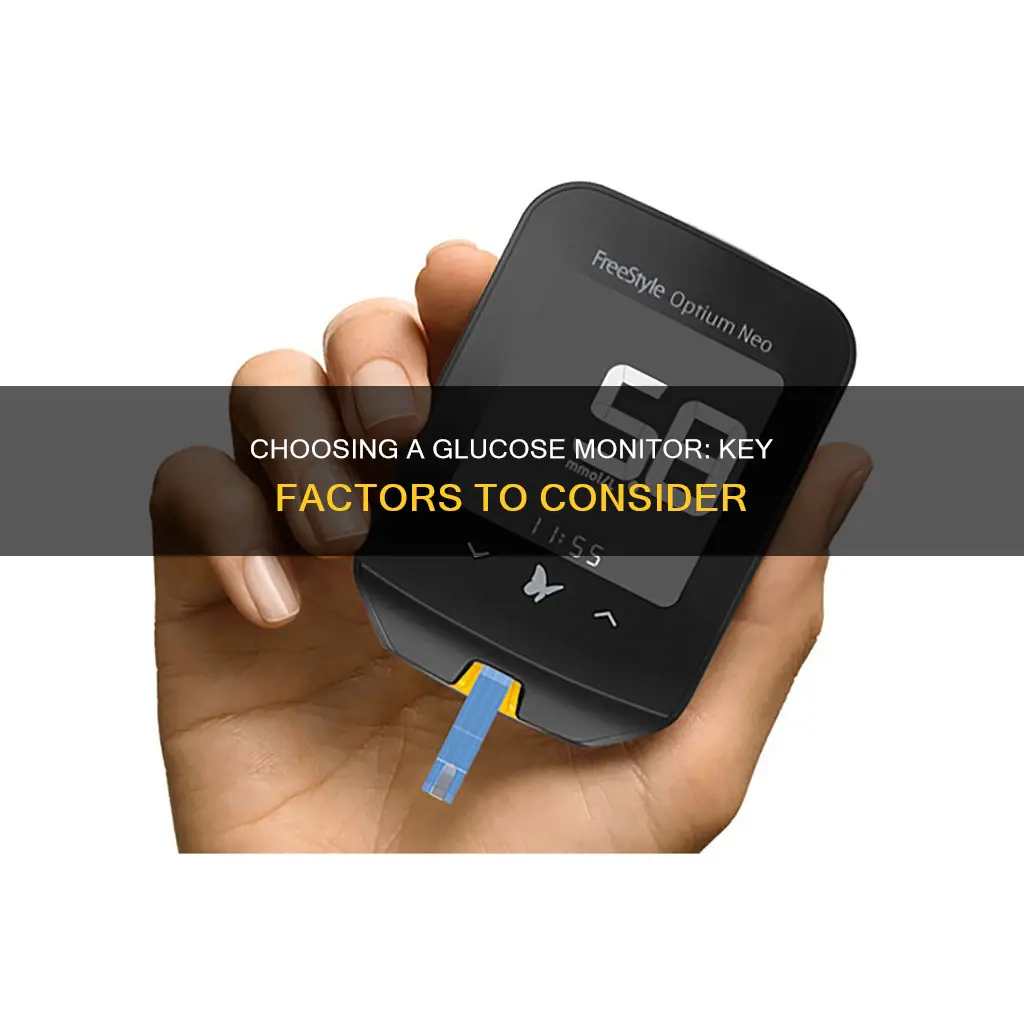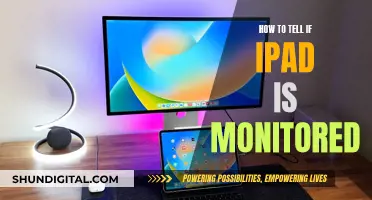
There are several factors to consider when choosing a glucose monitor. Firstly, check with your insurance company to see which monitors are covered in part or full, as this will help narrow down your options. Accuracy is critical when choosing a monitor, as your insulin dosage and treatment depend on the results. You should also consider the data display – whether the screen is large enough and if it has audio capability. Other features that may be useful include Bluetooth connectivity, storage capacity, backlight display, and a compact model. It is also important to choose a monitor that is easy to use and comfortable to hold. Finally, certain glucose meters require more blood than others, which is an important consideration for young children or the elderly.
| Characteristics | Values |
|---|---|
| Accuracy | Critical; must be within 15% of lab meter readings |
| Display | Easy to read, with a large screen and/or audio capability |
| User-friendliness | Easy to use, with Bluetooth connectivity and storage capacity |
| Size | Compact and portable |
| Cost | $40-60 for the monitor, $100/month for test strips |
| Speed | Results in 15 seconds or less |
| Memory | Stores results and calculates averages |
| Software | Syncs with apps and software to display data |
What You'll Learn

Cost and insurance coverage
The cost of a glucose monitor varies depending on the type of monitor and the brand. A continuous glucose monitor (CGM) system typically includes sensors, an annual receiver (or a connected smart device), and sometimes a transmitter. The cost of a CGM system can range from less than $2,000 to $7,000 a year without insurance or discounts, with an average cost of about $1,200 to $3,600 per year. The FreeStyle Libre systems, for example, cost about $2,000 annually without insurance. In contrast, the Dexcom G6 system can cost about $7,000 per year, and the Dexcom G7 can cost at least $5,000 per year.
The cost of a glucose monitor can be covered by insurance, depending on the type of insurance plan and the specific requirements. Many health insurance plans cover home diabetes monitoring devices, such as glucometers and CGMs. Original Medicare, for instance, covers blood glucose monitors as durable medical equipment (DME) that is prescribed by a doctor for use in the home. After meeting the Part B deductible, individuals pay 20% of the Medicare-approved amount. Medicare Advantage plans also cover diabetes monitoring devices, and most state Medicaid programs and Affordable Care Act (ACA) plans cover these devices as well.
For individuals without insurance coverage, there are financial assistance programs and discounts available to help with the cost of glucose monitors. GoodRx, for example, offers coupons and savings programs that can help reduce the cost of popular CGM brands such as FreeStyle Libre and Dexcom. Manufacturer savings programs are also offered by companies like Dexcom, which provides a copay savings program for individuals with commercial health insurance and a patient assistance program for those without insurance or with insufficient coverage.
Smart TV or Monitor: Which Should You Buy?
You may want to see also

Ease of use
When buying a glucose monitor, it's important to consider its ease of use. You'll be relying on this device to help manage your diabetes, so it's crucial to choose one that suits your needs and daily routine. Here are some factors to consider:
Simplicity and Comfort
The best glucose monitor for you will be one that you feel comfortable using. If a device feels too complicated or cumbersome, you may be less inclined to use it regularly. Look for a monitor that is simple and intuitive to use. The Contour Next One, for instance, is highly regarded for its user-friendliness, especially for beginners. It provides near-instant results and has a smartlight feature that uses colour-coded lights to indicate whether your blood glucose level is above, within, or below your target range.
Size and Portability
If you're often on the go, a compact and portable glucose monitor may be a better fit for your lifestyle. You want something that's small enough to carry around discreetly but not so small that it becomes uncomfortable to hold. Consider trying out different sizes before making your purchase.
Display and Visibility
Ensure the monitor's display is easy for you to read. If you have visual impairments, look for a model with a larger screen or audio capability that reads out the results. Some monitors also come with a backlight, making it easier to view the screen in low-light conditions.
Data Storage and Connectivity
Many modern glucose monitors can store your data, which can be helpful for tracking patterns and showing to your doctor. Some devices can store up to 500 or even 1,000 results. Additionally, consider whether you want a monitor that connects to your smartphone via Bluetooth or another app. This feature allows for seamless data transfer and can provide additional insights and recommendations.
Connecting Your Kemper to a Monitor: A Step-by-Step Guide
You may want to see also

Portability
In addition to size and weight, other features can enhance the portability of a glucose monitor. For example, Bluetooth connectivity can make it easier to transfer data to your smartphone or other devices without having to carry extra cables or adapters. A backlit display can also improve portability by making the screen easier to read in various lighting conditions, whether you're at home or on the move.
Some glucose monitors also offer additional features that can be useful when you're out and about. For instance, some devices have audio capability, which can be helpful if you have vision problems or find it challenging to read the screen in certain lighting conditions.
When considering the portability of a glucose monitor, it's also worth thinking about the power source. Devices operated by batteries can be easily transported without worrying about finding a power outlet for recharging.
Lastly, the cost of the glucose monitor and any additional accessories or supplies needed to use the device while travelling should be factored into your decision.
Understanding Bandwidth Usage Monitoring: What, Why, and How?
You may want to see also

Display and audio features
Data Display: It is essential to be able to see the numbers clearly on the screen. If you have vision problems, opt for a monitor with a larger screen or a model that has audio capabilities to "read out" the results aloud. Some glucose monitors also come with a backlight display, making it easier to view the screen in low-light conditions or at night.
Accuracy: Accuracy is critical when choosing a glucose monitor as your insulin dose and treatment options depend on the results. Look for a monitor that provides consistent results within the acceptable range specified by the Food and Drug Administration (FDA).
User-Friendliness: Choose a device that is easy to use and comfortable to hold. Avoid monitors that are too complicated, such as those requiring coding or having lengthy readings. Consider your lifestyle and needs—if you're often on the go, a compact model might be more suitable.
Bluetooth Connectivity: Bluetooth connectivity allows you to connect your glucose monitor to your smartphone, making it easier to record and track your readings.
Storage Capacity: Some glucose monitors have a large storage capacity, allowing you to store multiple test results. This can be helpful for reviewing your health patterns over time.
Time and Date Stamps: Look for a device that automatically includes time and date stamps with your readings. This feature provides valuable context for understanding your glucose levels and can help identify patterns.
Portability: Consider the size and portability of the device, especially if you travel frequently. You want a monitor that is easy to carry and comfortable to hold.
Cost: Glucose monitors vary in price, and the cost depends on the features you choose. Basic models can be found for around $40 to $60, while more advanced monitors with additional features may cost more.
Fixing Horizontal Lines on LCD Monitors: A Step-by-Step Guide
You may want to see also

Accuracy
The Dexcom G6 is considered the most accurate continuous glucose monitor (CGM) by Healthline. It is a sensor worn on the abdomen that transmits data to a corresponding app every 5 minutes. The Contour Next One is also praised for its accuracy, with proven accuracy within about 8.4% of lab values.
If you are looking for a traditional blood glucose monitor, the Rite Aid TrueMetrix Meter is a straightforward and affordable option. The results can be processed in as little as 4 seconds, and the meter can store up to 500 test results.
When choosing a glucose monitor, it is important to check with your insurance company to see which monitors are covered and to consider the cost of test strips. It is also worth considering other features such as data display, ease of use, and portability.
How Do Apartments Monitor Water Usage by Each Unit?
You may want to see also
Frequently asked questions
Key features to look out for include accuracy, data display, ease of use, size, and additional features such as Bluetooth connectivity or storage capacity. Some monitors also have audio capability, backlight display, and faster results.
Glucose monitors can vary in price depending on the features and brand. They typically range from $40 to $60, while test strips can cost around $100 a month.
Some recommended glucose monitors include the Contour Next One, FreeStyle Libre, Dexcom G6, Eversense, Guardian Connect System, and Rite Aid TrueMetrix Meter.







